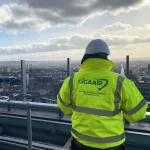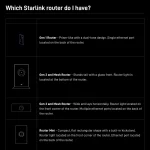Virgin Media O2 Parents May Sell Stake in UK Masts to Boost Full Fibre

The parents of ISP Virgin Media (Liberty Global) and mobile operator O2 (Telefonica) are reportedly considering a sale of their 50% stake in mast operator Cornerstone, which is part of a network sharing agreement with Vodafone (Vantage Towers). The extra funding would be used to help fuel their UK rollout of full fibre (FTTP) broadband.
In case anybody has forgotten, VMO2 currently has a couple of significant projects involving gigabit-capable Fibre-to-the-Premises (FTTP) technology. The first – Project Mustang – is working to upgrade the 14.3 million UK premises covered by their old Hybrid Fibre Coax (HFC) infrastructure to the latest 10Gbps capable XGS-PON based full fibre platform by the end of 2028 (here and here) – at a cost of c.£100 per home.
On top of that, VMO2 – supported by InfraVia Capital Partners – has also formed a new Joint Venture (here) to build a wholesale focused FTTP broadband ISP network that will cover “up to” 7 million additional UK homes. The goal of this is to “initially roll out fibre” to 5 million homes not currently served by VMO2’s network by 2026, with the “opportunity to expand” to an additional c.2 million homes (originally targetted for the end of 2027).
Advertisement
VMO2 has previously confirmed that it would cost £4.5bn – supported by £3.3bn of fully underwritten financing commitments and up to £1.4bn in equity commitments – to reach the first 5 million homes under the aforementioned expansion. The £3.3bn in that was said at the time to reflect “fully underwritten debt financing from a consortium of financing banks, including a £3.1bn capex facility.”
Lest we forget that VMO2 also needs to spend big on its rollout of 5G based mobile broadband technology. Back in 2021 the newly merged company pledge to “upgrade the UK” through a £10bn investment (capex) in both fibre and 5G infrastructure over the next 5-years.
The Mast Proposal
According to Bloomberg, industry sources have claimed that Telefonica SA and Liberty Global Plc are putting the feelers out to gauge interest in their 50% holding in UK mast operator Cornerstone. The operator, which claims to manage an estate of 20,000 sites (e.g. UK mobile masts / towers and rooftop sites), is said to be valued at about £10bn and such a sale would thus raise enough funding to fuel a big chunk of VMO2’s build plans.
At present no decision has been made on whether or not to actually proceed with the sale, although if the process were to start then it would probably follow the completion of Telefonica’s triennial strategy review during early 2023.
Advertisement
In recent years, it’s become increasingly common to see mobile operators selling off tower assets, often to help fund the rollout of 5G mobile technology (not all mobile operators have the same converged interests in full fibre and 5G as VMO2). Deals like this usually enable the selling party to retain preferential access, so that their strategic interests aren’t totally compromised by the loss of full control over such important assets.
Only a few months ago the UK’s Competition and Markets Authority (CMA) approved Spanish mobile tower operator Cellnex’s acquisition of CK Hutchison’s (Three UK) 6,000 assets, provided it sold at least 1,000 towers to ensure that it does not stifle competition. Last year also saw Vodafone move to commercialise their existing UK mast and tower sites under Cornerstone (here), which required agreement from O2.
Naturally, none of the parties concerned with today’s news have commented on it, as is fairly normal when concerning such speculation.
Mark is a professional technology writer, IT consultant and computer engineer from Dorset (England), he also founded ISPreview in 1999 and enjoys analysing the latest telecoms and broadband developments. Find me on X (Twitter), Mastodon, Facebook, BlueSky, Threads.net and Linkedin.
« Sky Broadband Customers in North West England Suffer Outage UPDATE4
EE UK Launch New Customer Packages to Improve Home Security »






















































Would be nice if VM allowed customers to pay the £100-200 per home for XGS-PON out of their own pocket rather than waiting for Postcode lottery on when you’re upgraded.
While that would be fantastic for customers willing to foot such a bill. It’s not feasible as the back haul of the network needs changed first in each area. So the post code lottery still stands. Good news is that all current Virgin media areas will become XGSPON capable within the next 5-6 years and in the meantime upgrades are being done on the existing infrastructure to increase the upload speeds as an interim resolution
@Andy I’m on Gig1 so I doubt I’ll get the increase in upload, but I’m also not bothered by upload as I don’t actually do much of it & it won’t make a difference for any games.
Want it before everyone else VM would be due the full cost of the upgrade as with Openreach FTTP on demand, but with more cost as VM may require more equipment to be installed.
Openreach FTTP on demand the equipment is already in the exchange, VM XGSPON it may not be so you get to buy them an OLT, too.
@AQX It doesn’t matter what package your on. When XGS-PON goes live in your area customers can migrate on to the new network. You will need new CPE. I expect they will pull out the old drop cable for duct space savings and install a new fibre drop. I have seen a SH implementation with an LC optical interface. They might end up going with some kind of ONT not sure if it’s been decided yet
As part of my VM broadband, TV, Landline and Mobile Jan 2022 contract renewal I was switched to O2 for my mobile. Some months ago I failed to receive a callback from my GP. On complaining the surgery was adamant that the GP had twice tried to call but I had not picked up. On investigation I established that a local O2 mast had an intermittent fault. I elected to receive update text msgs from O2 as to when the fault was going to be rectified. So far evey text has put back the fix date on a weekly basis. Could the reason be the mast will never be fixed whilst O2 infrastructure is sold off.
Clearly VMO2’s intention here is to create a player of comparable scale and capability to BT, whilst hoping to avoid BT’s expensive service obligation, and to shelter under Ofcom’s asymmetric regulation that holds BT to higher standards than other players. That will certainly play well to investors who love “compelling growth story” investments, but you have to wonder if they’ll (a) really raise the cash for all of these grandiose growth plans, and (b) whether they’ll successfully execute these multiple concurrent investment programmes given that VM have never been good at delivering on investment promises (Project Lightning, for example), and are still in the throes of a long, protracted and complex merger. And even with this increased reach, is VMO2 a survivable business if it no longer has a speed advantage, but sticks with its appalling customer service, and 1990s call centre operating model? I wouldn’t want my pension invested in any of this!